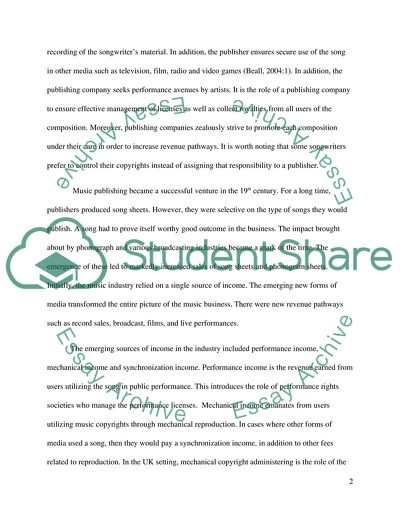Cite this document
(The Ways in Which Music Copyrights Are Exploited Essay - 1, n.d.)
The Ways in Which Music Copyrights Are Exploited Essay - 1. https://studentshare.org/music/1784599-explain-and-discuss-some-of-the-most-commonly-used-ways-in-which-music-copyrights-have-been-exploited-in-order-to-maximize-the-earning-potential-of-those-copyrights-by-the-uk-music-publishing-industry-over-the-past-50-years
The Ways in Which Music Copyrights Are Exploited Essay - 1. https://studentshare.org/music/1784599-explain-and-discuss-some-of-the-most-commonly-used-ways-in-which-music-copyrights-have-been-exploited-in-order-to-maximize-the-earning-potential-of-those-copyrights-by-the-uk-music-publishing-industry-over-the-past-50-years
(The Ways in Which Music Copyrights Are Exploited Essay - 1)
The Ways in Which Music Copyrights Are Exploited Essay - 1. https://studentshare.org/music/1784599-explain-and-discuss-some-of-the-most-commonly-used-ways-in-which-music-copyrights-have-been-exploited-in-order-to-maximize-the-earning-potential-of-those-copyrights-by-the-uk-music-publishing-industry-over-the-past-50-years.
The Ways in Which Music Copyrights Are Exploited Essay - 1. https://studentshare.org/music/1784599-explain-and-discuss-some-of-the-most-commonly-used-ways-in-which-music-copyrights-have-been-exploited-in-order-to-maximize-the-earning-potential-of-those-copyrights-by-the-uk-music-publishing-industry-over-the-past-50-years.
“The Ways in Which Music Copyrights Are Exploited Essay - 1”. https://studentshare.org/music/1784599-explain-and-discuss-some-of-the-most-commonly-used-ways-in-which-music-copyrights-have-been-exploited-in-order-to-maximize-the-earning-potential-of-those-copyrights-by-the-uk-music-publishing-industry-over-the-past-50-years.


